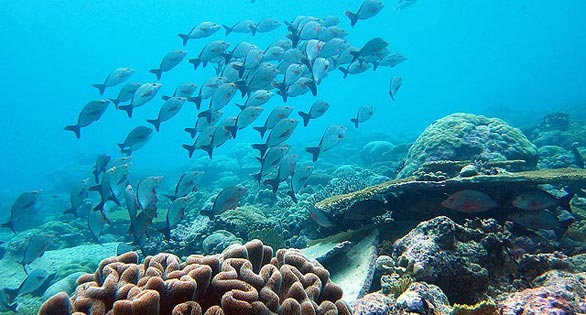Unsuspecting fish from marine protected areas: easy targets for spear fishers
Big fish that have grown up in marine reserves don’t seem to know enough to avoid fishers armed with spear guns waiting outside the reserve. This, say researchers in a new paper, is good thing, both for native fishers and the greater good of fish populations.
The latest research by an Australian team working in the Philippines into the effects of marine reserves has found there is an unexpected windfall awaiting fishers who obey the rules and respect reserve boundaries – in the form of big, innocent fish wandering out of the reserve.
“There are plenty of reports of fish, both adults and juveniles, moving out of reserves and into the surrounding sea. Having grown up in an area where they were protected from hunting, we wondered how naïve they would be with regard to avoiding danger from humans,” says Fraser Januchowski-Hartley of the ARC Centre of Excellence for Coral Reef Studies.
The answer is: pretty trusting.
“More Catchable”
“Educated fish normally turn tail and flee when a diver armed with a spear gun approaches within firing range of them. The typical flight distance is usually just over four metres,” he explains.
“However in our studies of marine reserves in the Philippines, Vanuatu and Papua New Guinea, where spearfishing remains a major way of harvesting table fish, we discovered that reserve-reared fish were much less wary and allowed people to get much closer.
“The fish are literally more catchable.”
“Naivete Radius”
The team studied fish across the boundaries of marine reserves from 200m inside the protected areas to 200m into the fished areas. They used underwater markers and measuring tapes to measure the ‘flight initiation distance’ of fish targeted locally by spearfishers. This indicates how close a skin diver can approach to a large fish before it decides to turn and flee.
They found that target fish living in fished areas were typically much warier of divers, and took flight at distances a metre or two further away, than ones living within the reserve.
They also established that the ‘naivete radius’, whereby more catchable fishes spill out of the marine reserves extended for at least 150 metres from the boundary.
Improving Local Food Supplies
The team’s findings suggest that fishers are more likely to catch fish that stray out of the reserve, and so improve the local fish harvest. This may help fishers become more supportive of marine reserves.

Coauthor of new study Dr. Nick Graham of James Cook University and the Centre of Excellence for Coral Reef Studies, Australia.
“In these parts of the oceans, spear fishing is still very much about survival for humans and putting food on the family table – so it is important that local fishers feel they are deriving some benefit from having a local area that is closed to fishing, or they may not respect it,” says Dr Nick Graham, a co-author on the study.
“This information is also useful in traditional reserves where fishing is taboo most of the time, but then they are opened for fishing by village elders just a few days a year.
“On the face of it, this work suggests that marine reserves can play an important role in putting more fish on the table of local communities in these tropical locations – as well as conserving overall fish stocks and replenishing those outside the reserve,” Januchowski-Hartley says.
SOURCES
From materials released by the ARC Centre of Excellence for Coral Reef Studies, James Cook University, Australia
The team’s paper ‘Spillover of fish naïveté from marine reserves’ by Fraser A. Januchowski-Hartley, Nicholas A. J. Graham, Joshua E. Cinner and Garry R. Russ appears in the latest issue of the scientific journal Ecology Letters.
Abstract
Spillover of adult fish biomass is an expected benefit from no-take marine reserves to adjacent fisheries. Here, we show fisher-naïve behaviour in reef fishes also spills over from marine reserves, potentially increasing access to fishery benefits by making fishes more susceptible to spearguns. The distance at which two targeted families of fishes began to flee a potential fisher [flight initiation distance (FID)] was lower inside reserves than in fished areas, and this reduction extended outside reserve boundaries. Reduced FID persisted further outside reserves than increases in fish biomass. This finding could help increase stakeholder support for marine reserves and improve current models of spillover by informing estimates for spatial changes in catchability. Behavioural changes of fish could help explain differences between underwater visual census and catch data in quantifying the spatial extent of spillover from marine reserves, and should be considered in the management of adjacent fisheries.






